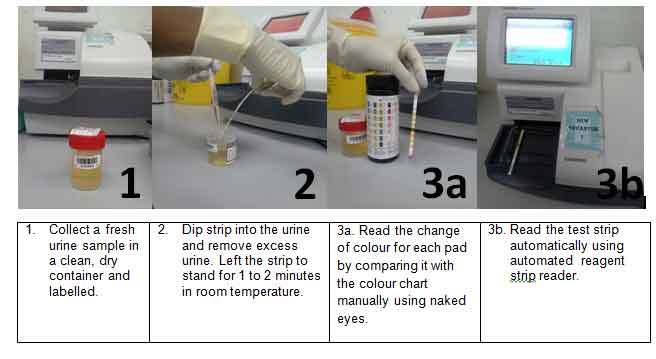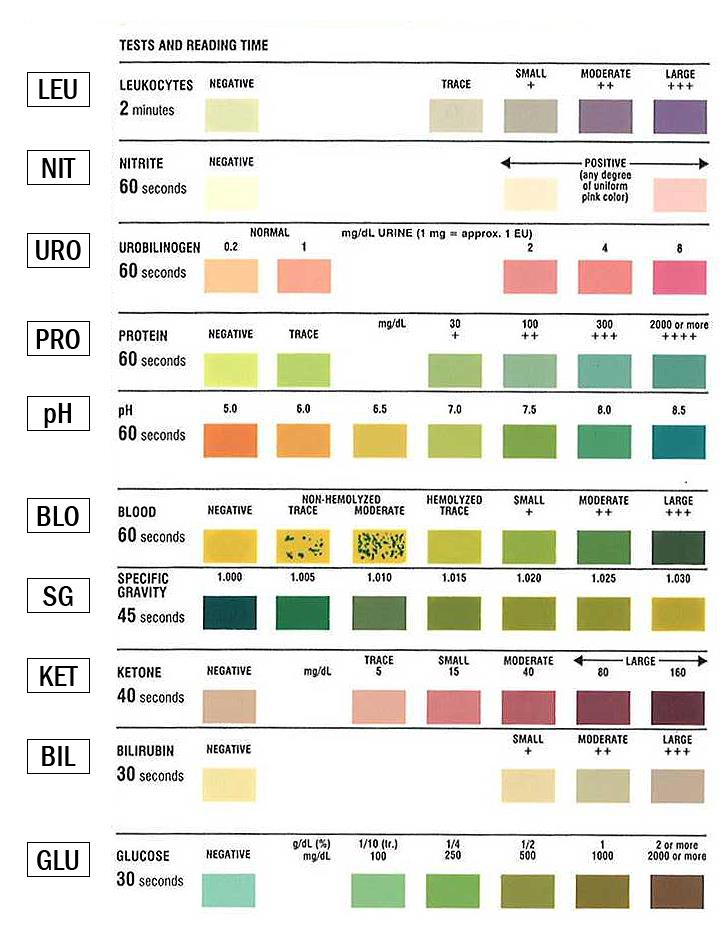Definition
Have you seen a doctor because of fever, having to urinate more often than usual, pain or burning during urination, frequent sensation of having to urinate, even when the bladder is empty, cramping and pressure in lower abdomen or lower back and foul smelling urine, cloudy or bloody urine?
Normally, with this kind of symptoms doctor will recommend us to do urine test strip. This test is simple and easy. It consist of 5 to 10 test in one strip includes protein, glucose, ketones, blood, bilirubin, urobilinogen, nitrite, leukocytes, as well as testing of pH and specific gravity. Please refer the detail in the table below.
Please take note that although urine test strip using same kind of method as urine pregnancy test and urine drug of abuse but it use different type of urine strip.
What is the purpose of Urine Test Strip?
From the urine test strip result, a doctor can diagnoses problems such as urinary tract infections or we need to do further test such as urine microscopic, urine culture and sensitivity, Glucose, Renal Profile or Liver Function Test using different type of sample example blood or others fluid. This further test will confirm other diseases such as diabetes mellitus, kidney diseases or liver diseases.
However, if your results is normal but have any symptom as above, maybe you will recommend to repeat this test because probably your urine is insufficient, diluted or nitrite (chemical produce from reduction nitrate to nitrite process done by bacteria) not produced yet.
Methods of measurement
Procedure for this test are shown below :

Results
Results are in qualitative and semiquantitative. The test strip that have been dip into the urine will change in color .Than the colour produce in the strip need to be compare with colour chart as below. ( Step 3 ).
(Chart 1 – Colour chart provided by the manufacturer: Source Siemens Multistix 10 SG)

|
Parameter
|
Normal reference range
|
Influence factor such diet and environment that interfere results |
Clinical significance
|
|---|---|---|---|
| Blood | Negative | False Positive : Taking any food that can colour the urine or having menstrual. Urine exposed to hypochlorite as chlorox.
False Negative :Taking Vitamin C (ascorbic acid) |
|
| Bilirubin | Negative | False Positive : Taking medicine such as chlorpromazine or phenazopyridine.
False Negative :Taking Vitamin C (ascorbic acid). Urine exposed to sunlight or lamp. |
|
| Urobilinogen | 3.2 – 16 umol/L | False Positive : Urine contaminated with p-aminobenzoic acid.
False Negative : Urine exposed to sunlight or lamp. |
|
| Ketone | Negative | False Positive : Taking low carbohydrate such as wheat or rice, vomit or diarrhoea’. Urine exposed to moisture too long. Taking medicine such as MESNA and captopril. |
|
| Protein | Negative dan Trace (<0.15g/L) | False Positive : Extreme exercise, dehydrated, taking high protein or emotional stress. Urine exposed to hypochlorite as chlorox or blood. |
|
| Nitrite | Negative | False Positive : Urine exposed to room temperature more than 2 hours.
False Negative : Taking Vitamin C (ascorbic acid). Collect urine so early (less bacteria incubation period in bladder). |
Urinary Tract Infection |
| Glucose | Negative | False Positive :Taking Vitamin C (ascorbic acid).
False Negative : Low glucose renal threshold and high ketone. |
|
| pH | pH5 hingga pH7.5 | More alkaline : Diets with a high content of vegetables and citrus fruit.Vomit or starvation. Urine exposed to room temperature for more than 2 hours. |
|
| Specific Gravity | 1.002 hingga 1.030 | False Positive : Dehydrated, diarrhoea or taking antibiotic or diuretic medicines (substance that removes water from the body by promoting urine formation and the loss of salt (sodium). Urine exposed to room temperature for more than 2 hours. | Diabetis insipidus |
| Leukocyte esterase | Negative | False Positive : Urine exposed to Formalin or hypochlorite as chlorox. Taking Vitamin C (ascorbic acid). High specific gravity.
False Negative : Glucose level more than 3g/dL. Taking antibiotic such as cephalexin, cephalotin and tetracycline. |
|
Each parameter or combine of parameter can used to diagnosed your problem BUT a definitive clinical diagnosis should not be based on the results of a single test. Further test need to be done.
Urine collection
A first morning sample is preferred because at that time our urine is more concentrated. Abnormal results may be more obvious. However, urine random (urine collect at any time) also acceptable.
Procedure for urine collection:
- Use clean container which have been labelled with your name.
- Wash hands thoroughly with soap.
- Cleanse down centre of vulva or penis and dry with paper towel before start urinated.
- Do not collect the initial stream of urine since it may be contaminated with skin and urethral bacteria.
- Void midstream portion into clean container until half full. Make sure your urine is sufficient.
- Please don’t add tap water into your urine.
- Carefully screw cap on container to make sure no leak.
- Wash your hands again.
- Send your sample to lab personnel within 2 hours after collection because urine will shift to alkaline (bacteria can change urea to ammonia ) if exposed in room temperature too long.
- Tell your doctor if you :
- Drinks too much water or taking diuretics (avoid diluted urine).
- Taking any food that can change colour of the urine such as blackberries,dragon fruit, beets or certain medicine such as Vitamin B, phenazopyridine (Pyridium), rifampin dan phenytoin (Dilantin).
- Menstruating or close to starting your menstrual period.
References
- Susan,K.S Marjorie S D L. Urinalysis and Body Fluids,4th Edition,2001.
- https://labtestonline.org
- www.nhs.uk/chq
- www.specimencare.com
- Package insert,Siemens Healthcare Diagnostics Pty Ltd.rev 04/09.
| Last Reviewed | : | 08 June 2016 |
| Writer/Translator | : | Harani bt. Mohd Shahidin |
| Accreditor | : | Sairi bin Satari |







